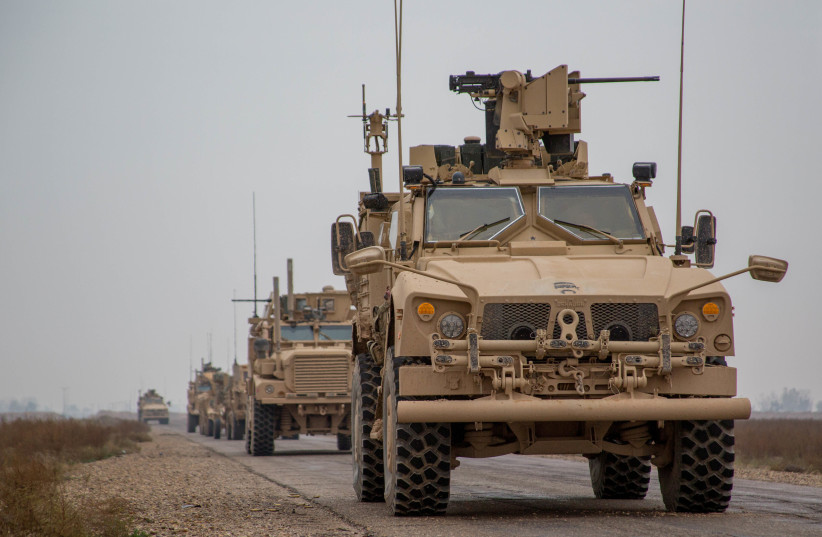The Jerusalem Post – Who is undermining US-backed forces in Deir Ezzor and Euphrates area?

Original article by Seth J. Frantzman , Jerusalem Post, 09 August 2020
In the first two weeks of August a series of incidents in the desert regions and areas adjoining the Euphrates River in eastern Syria have seen an uptick in assassinations and protests. This area is controlled by the Syrian Democratic Forces (SDF), the main anti-ISIS force backed by the United States. However, this area also adjoins Syrian-regime-held areas where there are Iranian-backed militias. There are also tribes here, some of which were once under ISIS control, and others possibly being sympathetic either to their own interests, the Syrian regime or even Turkey. It’s a complex area and many countries have an interest in keeping it quiet – or making it boil with tensions. To try to understand the complexity, I’ve provided various reports below from Arabic media, leaving many of the inconsistencies in them, including the spelling of several names, to get a sense of what may be competing narratives and agendas. Although some of these reports are from Turkey or Russia, many of these media have local Arabic sources and write up their reports also in Arabic. On August 2, the Syrian Observatory for Human Rights (SOHR) said that an SDF fighter was killed near AL-Kebar village in the western countryside of Deir Ezzor. It said this was one of hundreds of fighters and locals killed in attacks over the past years in this and adjoining areas. Anadolu News, a pro-government channel in Turkey, wrote on August 4 that a civilian was killed and three others wounded in a clash with the SDF. Turkey calls the SDF the “YPG/PKK” which Ankara views as a terrorist organization. In October 2019, Turkey invaded eastern Syria, attacked the SDF and forced the US to withdraw from a border area. The US now has forces in the area of the Euphrates River (sometimes called the Middle Euphrates River Valley) and says it is securing oil.
A LITTLE history is necessary to understand this area before plunging into more details. ISIS conquered the region, using the Euphrates like a highway to move and infiltrate Iraq, in 2013 and 2014. Some of the tribes here, according to diplomats interviewed over the years, were once sympathetic to the Saddam Hussein regime – even more than the Assad regime, despite being in Syria. They had family connections on both sides of the border. Some joined ISIS or trafficked jihadists, helping insurgents move to Iraq to fight the US, a system the Syrian regime supported. When ISIS took over, it massacred Bedouin tribes that resisted, such as the Shaitat. The SDF, backed by the US, retook this area in March 2019. In February 2018, while the SDF was still fighting ISIS, Russian mercenaries working for the Syrian regime tried to cross from Deir Ezzor city and attack the SDF to seize oil and gas fields. They failed and were killed by US warplanes. Later, Iranian-backed groups set up shop on the western bank of the Euphrates at Albukamal, Mayadeen and other areas. The Iranian IRGC traffics weapons to Hezbollah via this corridor. Into this mix comes frequent controversy. The pro-Turkish media claims there was an assassination of Mutchir al-Hammud al-Cedan (Sheikh Mutashar Hammoud Al-Hafil), the leader of the Aqeedat (Akaidat) tribe. Turkey claims that the tribal leader refused to attend an SDF meeting with its leader Mazloum Kobani. It appears the Turkish report is based on slight detail changes of a SOHR report on August 4 that said a woman was killed in a shootout between the SDF and “unidentified gunmen in the village of Al-Hawaij.” The observatory said that the SDF deployed after protesters blocked roads in the area. Omar Abu Layla, a local journalist, noted that a commander of the “SDF-linked Al-Bukamal regiment was killed by unknown gunmen” on August 6. He said that “Assad cells” were working to “sow sedition between the Arab and Kurdish components” of the SDF. A social media account said the SDF officer was named Shaaban al-Maat; he was shot from a motorbike near Hajin.
MEANWHILE, Russia’s RT also reported the clash. Russia’s foreign ministry over the weekend condemned the US for “illegally occupying” and “robbing” natural resources. This is likely a reference to the oil deal by an American company with the SDF that was made public in early August. The RT report says there were protests against the US and SDF at Theban, Shuhail and Huwayj. RT said locals blamed the SDF for assassination attempts on tribal leaders. The Kurdish channel Rudaw noted that the clashes began on August 6 after peaceful protests against the assassination turned violence. Weapons were used and two SDF members were killed. Later an SDF commander named Ahmad Abu Khawla told reporters that a vehicle was blown up and saboteurs were responsible. The American embassy condemned the attack on Facebook. “The US condemns the attack on Sheikh Mutashhar al-Hamoud al-Jadaan al-Hafl, Sheikh Ibrahim al-Khalil al-Aboud al-Jadaan al-Hafl and notables of the Aqeedat tribe.” The Rudaw report was posted by the Rojava Information Center, which is sympathetic to the SDF. Another report at Asharq Al-Awsat said the local SDF headquarters had been occupied by protesters and that six were injured. This report provided more details on the assassination, claiming that another sheikh, Ibrahim Khalil al-Jadaan al-Hafil, was wounded. Men on motorcycles had shot at the tribal leaders near Ragheeb junction near Hawayj. The locals demand the SDF leave the town. It appeared several SDF members were briefly detained in the clash. On August 8, another clash took place in a nearby village all Al-Jadid Aqeedat (Akidat) when “unidentified’ gunmen fired on an SDF post. The next day, Sunday, SOHR reported that the SDF, backed by helicopters and the coalition, raided the town of Huwayj. This was the third day of clashes the report said, although it appears more like the fifth day. People were arrested “for their loyalty to the Syrian regime,” SOHR noted. Seven young men were detained in Al-Shuhail village. Six civilians, five from one family, were detained. The New Arab has a slightly different version of these events. It argues they began with SDF Internal Security Forces conducting a security sweep in al-Shuhail and Hawayj to stop ISIS cells that were “stirring up sedition.” Two SDF fighters were killed by ISIS sleeper cells in recent days, the report says. It took place in the context of an attempt by unidentified elements to assassinate “the most prominent tribal sheikh in the countryside of Deir Ezzor, Ibrahim Khalil Abboud Al-Jadaan Al-Hafil of the Aqeedat tribe, the largest of the Arab tribes in this countryside.” That had sparked unrest. The attack on Al-Hafil had killed Mutashar Hammoudd Al-Hafil, a well-known “notable of the tribe.”
LOCALS BLAME the “Qasd” (QSD) or SDF for the attacks and claim that the US-backed forces, which they complain of being “Kurdish,” are trying to “empty the area of tribes.” The New Arab report provides the larger context. It notes that in recent months, locals have rejected a new curriculum linked to the civilian leadership of the autonomous region of eastern Syria, which is controlled by the SDF. It points out tension between the Arab tribes and the Kurdish leadership of the SDF, which the latter has tried to mollify. It also notes that the US condemned the attack on the sheikh. “The majority [of people in this region] adhere to tribal customs. Perhaps the most prominent of these tribes and clans are the Shammar, Jabour, Aqeedat, Baggara, Bou-Shabban, Albu-Nimr, Adwan, Qais, An-Naim, Tayy and other tribes.” It also notes that the area includes several large towns, “including Al-Busirah and Hajin and the towns of the Al-Shaitat clan, which are Al-Hammam, Al-Gharanij and Al-Kashkiya.” It says a protest happened in Kashkiya against the SDF and the curriculum. Al-Mayadeen, which is generally pro-Syrian regime and pro-Hezbollah, also has a report on the tensions in Deir Ezzor areas. It notes that there were clashes between the Aqeedat (Akidat) tribe and the “Qasd militants.” It described the US-backed SDF as imposing a curfew and blamed the US for the actions. It said the area of clashes was near Al-Latwa and Al-Barid and included machine guns and RPGs. “Clashes also took place in the village of Swaidan Island and in the vicinity of the town of Dhiban.” It said this area was the center of the tribe’s populace.More reports can be found on social media. Pro-Syrian-regime accounts note that the SDF has “abducted a number of civilians.” These pro-regime tweets claim the locals want the US “occupation forces” to leave. They assert that Washington sent reinforcements to the area on Saturday night. The pro-regime accounts also accuse the SDF of looting. Others, who oppose Iran, say that Tehran is following the events closely after the assassination of the sheikh. Others report that the tribes have appealed to the US to reduce the number of Kurdish officers in the area. One video shows someone reported to be Sheikh Abdullah Al-Muhainsi, according to journalist Omar Abu Layla, who accuses the man in the video of being “malicious” and lying.
THE OVERALL picture in eastern Syria’s Deir Ezzor region near the Euphrates – an area of around 120 km. to the Iraqi border in which the Aqeedat tribe dominates around 25 km. of frontage along the Euphrates River – is that a sensitive area is experiencing unrest. The US has had to juggle complex tribal realities here even as it wants to draw down forces. This is the worst possible situation to be in because the Iranian and Russian-backed Syrian regime sense US weakness. Turkey also wants to prey on divisions and stoke up tensions. ISIS cells are operating and they may also work with their enemies if they think they can undermine other enemies. The US has long considered how best to empower the local Sunni Arab tribes. At the same time, however, America has a problem, because its withdrawal from northern Syria led to a Turkish invasion, which forced the SDF to work with Russia and the Syrian regime in Kurdish areas that Turkey threatened. This left a kind of rump polity in the desert south of Hasakah and east of Deir Ezzor, the area the US wants to work with the SDF. It is now primarily an Arab area, where the US wants to secure the oil. But the US can’t simply create a new version of the SDF, since it already helped the Kurdish YPG create the SDF in 2015. So America and the SDF must work within the paradigms they have with little to no international support – and with ISIS detainees chafing to escape, and Turkey, Iran and Russia undermining US and SDF efforts. Turkish drones, for instance, attack people near Qamishli and Turkish agents have tried to smuggle people out of Al-Hol camp where ISIS family members are present. Covid-19 is also a threat; the UN has shut the humanitarian border at Russia’s behest. Now, with a US oil company seeking to help rehabilitate the oil facilities, every small clash has geopolitical ramifications. This appears to be what has happened so far this month.

